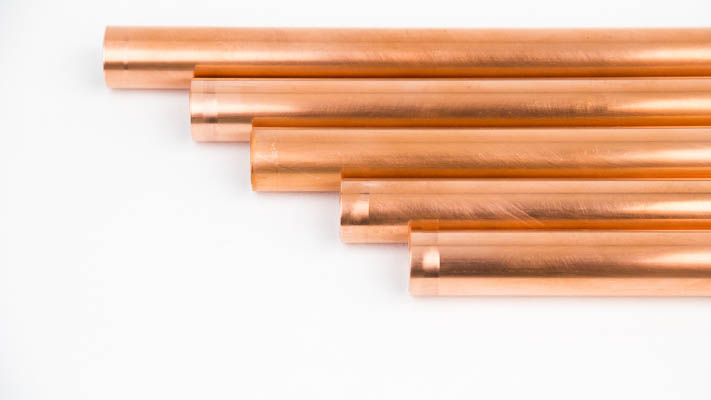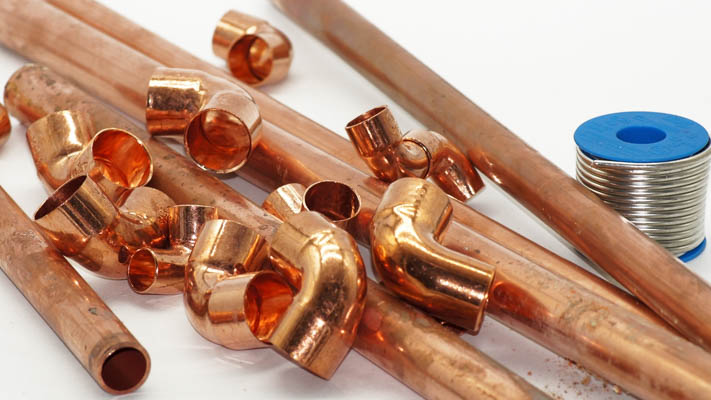What Is the Thinnest Type of Copper Pipe?
The thinnest type of copper pipe commonly used in residential plumbing is Type M copper. Easily identifiable by its red markings, Type M has the thinnest wall thickness of all copper pipe types approved for water supply lines in certain residential settings.
Here's a quick comparison of the three copper pipe types by wall thickness:
- Type K (Green markings): Thickest walls - used for underground or high-pressure systems
- Type L (Blue markings): Medium thickness - ideal for most residential and commercial uses
- Type M (Red markings): Thinnest walls - used in limited residential situations or low-pressure applications
Due to its thinner walls, Type M is more lightweight and less expensive than its counterparts. While this might sound like a benefit for budget-conscious projects, its reduced thickness makes it more vulnerable to corrosion, pinhole leaks, and pressure damage—especially over time.
If you're looking for more details about copper pipes, we have an article that breaks down everything you need to know about the different types of copper.
Can You Use Thin Copper Pipe for Home Repipes?
Technically, Type M copper pipe can be used for residential plumbing, but it's not always recommended.
Because of its thin walls, Type M is more prone to failure—especially in systems that experience regular pressure changes, highly alkaline water (known as hard water), or shifting soil conditions.
In fact, many professional plumbers and building codes across the U.S. discourage or prohibit its use for its:
- Shorter lifespan: Type M degrades faster, increasing the risk of leaks.
- Increased maintenance: More frequent repairs may be needed over time.
- Code restrictions: In many areas, building codes now require the use of more durable piping (typically Type L) for repiping projects.
Type M is best reserved for low-pressure applications such as some HVAC systems (e.g., condensate drain lines), vacuum lines, or compressed air systems, as well as budget-specific new construction in areas with stable water chemistry.
For a full home repipe—especially if you're looking for something reliable and long-lasting—Type M simply doesn't provide the strength or durability needed for the job.
Type M vs. Type L Copper: Which Should You Use?
When deciding between Type M and Type L copper pipe for a full home repipe, Type L is the clear choice for long-term performance, safety, and compliance.
Here's how they compare:
- Wall thickness and durability: Type L has thicker walls that resist corrosion and pressure better, while the thinner walls of Type M are more prone to leaks and early failure—especially in older homes or areas with acidic water.
- Versatility: Type L can be used for both hot and cold water lines and is available in rigid and flexible forms, making it easier to install in tight or complex areas. Type M is rigid only and less suitable for demanding plumbing setups.
- Building code compliance: Type L is more commonly accepted (and often required) by local building codes due to its proven durability. Type M may not meet code in certain regions, so it's important to check local regulations before using it.
- Value over time: While Type M is more affordable upfront, it tends to require more repairs and replacements over time. Type L costs more initially but offers better long-term value thanks to its reliability and lifespan.

At Repipe Specialists, we only use American-made Type L copper for all of our full home copper repipes. By investing in American-made Type L copper, you're choosing a solution that combines durability, versatility, and compliance for your home's plumbing system. For more information, we have an article dedicated to the differences between Type M and Type L copper pipe.
Contact us today, and one of our local repipe consultants will explain all your Type L copper repipe options and provide you with a free written, fixed-price quote.
Get your free estimate today
With over 75,000 repipes completed, we've perfected our One-Stop Repipe™ for your home.
Get a Quote for Your Type L Copper Repipe
Here at Repipe Specialists, we've fully replaced the plumbing in over 60,000 homes since 1991. A Type L copper repipe will save you financially into the future (we also back our repipes with a lifetime warranty). We continually get positive customer feedback from customers about their overall home repipe experiences. We often exceed their expectations on:
- Speed: Our repipe crews typically complete a repipe in a day, returning on another day for wall patching.
- Convenience: Through our One-Stop Repipe™ process, we handle everything from permits, to wall patching, to inspections.
- Cleanliness: Our crews are trained to protect your home while working (we cover all surfaces with protective sheeting), and to clean up fully at the end of each day.
- Peace of Mind: Repipe Specialists is a fully licensed plumber in every state we operate in, and we back all of our repipes with a lifetime warranty.
- Financing programs: To help take the sting out of unplanned repipe expenses, we offer several financing programs.
- Price: As a specialist that performs hundreds of repipes a week, we can deliver high quality repipes at a lower cost vs generalist plumbers. Our quotes typically range from $4,500 to $15,000 depending on the size and complexity of your project. We have an article that covers repipe cost factors in detail.
Schedule a free in-home consult, and one of our local repipe consultants will explain all your Type L copper repipe options and provide you with a written, fixed-price quote.

